- Table of Content
- 1.A patchwork im...
- 2.Come see SUN!
- 3.Battle of the ...
- 4.Review of sola...
- 5.Review of geom...
- 6.PROBA2 Observa...
- 7.The Internatio...
- 8.Noticeable Sol...
- 9.Geomagnetic Ob...
- 10.The SIDC Space...
- 11.Review of iono...
- 12.Action!
2. Come see SUN!
3. Battle of the Scientists
4. Review of solar activity
5. Review of geomagnetic activity
6. PROBA2 Observations (14 Mar 2022 - 20 Mar 2022)
7. The International Sunspot Number by Silso
8. Noticeable Solar Events (14 Mar 2022 - 20 Mar 2022)
9. Geomagnetic Observations in Belgium (14 Mar 2022 - 20 Mar 2022)
10. The SIDC Space Weather Briefing
11. Review of ionospheric activity (14 Mar 2022 - 20 Mar 2022)
12. Action!
A patchwork image of the Sun
On 7 March, 2022, the high-resolution telescope of the Extreme Ultraviolet Imager (EUI) onboard the Solar Orbiter spacecraft made a mosaic image of the solar disk. Over a period of more than 4 hours, the satellite aimed at different positions each time capturing a small square of the Sun at very high resolution. These images were then stitched together like a patchwork. The result was an extremely detailed image of the entire Sun.
a 9700 x 9700 pixel grid. We repeat: a 9700 x 9700 pixel grid

This image is a mosaic of 25 individual images taken on 7 March by the high resolution telescope, part of the Extreme Ultraviolet Imager (EUI) instrument. In total, the final image contains more than 94 million pixels in a 9700 x 9700 pixel grid (We repeat: 9700 x 9700 pixel grid), making it the highest resolution image of the solar disk and outer atmosphere ever taken.
A 4K TV screen has a resolution of 3840 x 2160, which means you would need the equivalence of ten (!) 4K TV screens to look at this image at native resolution.
Emil Kraaikamp made a tool such that you don't need to put ten screens on your desk. Zoom in to marvel at the details on https://www.stce.be/EUImosaic.
Credit: ESA and NASA/ Solar Orbiter/ EUI team; Data processing: E. Kraaikamp (ROB).
Solar Orbiter was located halfway between the Sun and the Earth when this mosaic image was made. David Berghmans: 'We needed 25 images to get the full picture of the Sun. We can't point the EUI instrument separately, so for each image we had to slightly change the orientation of the full satellite, a feat that took 4 hours and 30 min.' After the images were sent from the satellite to the ground, our scientists meticulously pieced them together. Not easy, because during those 4 hours and 30 minutes the sun rotates a little on its own axis and the solar atmosphere changes appearance.
The result is the sharpest image of the solar atmosphere ever taken. This mosaic image was taken when Solar Orbiter flew exactly between the Earth and Sun. This image can therefore easily be compared with similar images from other telescopes that orbit Earth. Although the latter are not as sharp, they can be used to calibrate the brightness of EUI's images.
On March 26, Solar Orbiter will be even closer to the Sun, which will give us images that will be nearly twice as sharp yet. However, from this close it is no longer possible to capture the entire solar disk in one mosaic, this would require too many images and especially too much reorientation of the satellite. Scientists will therefore point out the most interesting areas on the sun, and from those areas we will then take fast movies to follow the movements in the corona. This closest approach to the Sun (scientists speak of 'perihelion') is a highlight for the EUI team, both at the Royal Observatory of Belgium from where the instrument is operated, and with the European partners that have been essential during the construction of EUI.
Come see SUN!
This light artwork brings you closer to the sun than ever before!
Marvel at the beauty of our closest star with this lifelike representation of the sun. A 3D projection with state-of-the-art telescope images on a gigantic hanging 6-meter diameter balloon shows 10 weeks of the life of our Sun. Smoke and sound effects complete the unique experience. This spectacular piece of light art brings you closer to the sun than you’ve ever been before.
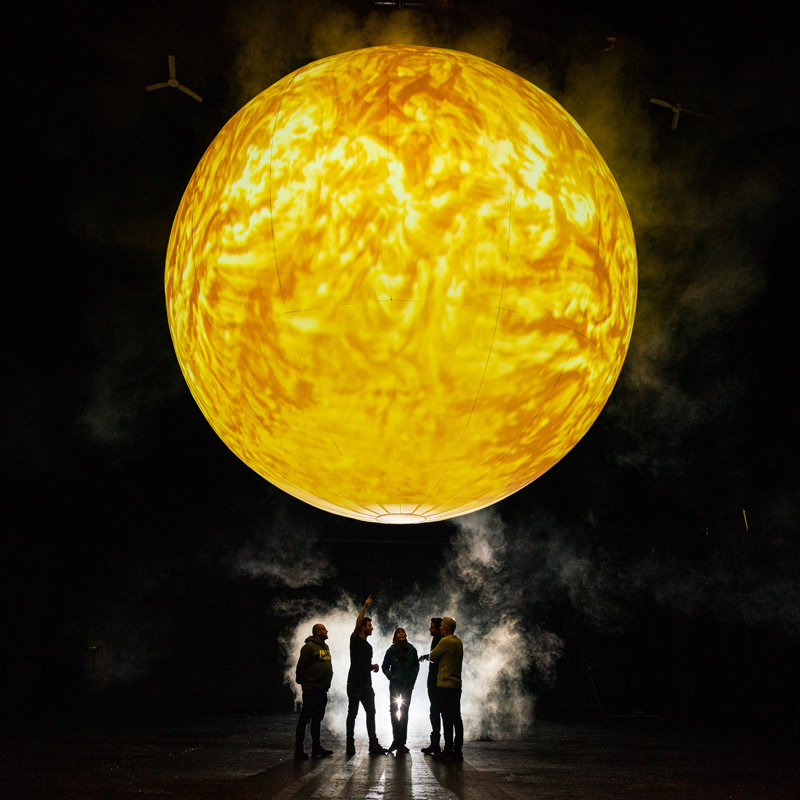
SUN is an installation by British artist Alex Rinsler and solar expert Prof. Robert Walsh (University of Central Lancashire). With this installation in the AfricaMuseum, in cooperation with the Solar-Terrestrial Centre of Excellence (STCE) in Uccle, the spectacular artwork is shown outside the United Kingdom for the very first time.
The Sun and the climate
The Sun determines life and climate on this globe. The climate is changing due to human activity. Climate change is one of the greatest challenges humanity is facing. The AfricaMuseum and the STCE conduct world-leading research on the Sun and the climate on Earth. The installation in the permanent exhibition of the AfricaMuseum highlights some of this research.
The AfricaMuseum presents projects on the impact of tropical rainforests on the climate, and on the impact of climate change on the spread of tropical diseases and natural hazards such as landslides. The STCE studies long-term variations of the Sun that affect Earth's climate. The difference between solar radiation that strikes the Earth and the radiation that is sent back into space, is the key to climate change and also subject of research.
Family Sunday
On Sunday, April 10, inspired storytellers will bring African and Scandinavian stories about the Sun to children and slightly older Sun-lovers. Take a seat by the light artwork and dive into the world of aardvarks, bats and the northern lights during one of the storytelling moments.
Registration is done on site.
More info on https://www.stce.be/content/MarvelAtTheSun
Here is the latest on packing up SUN from the UK. The dogs make sure everything runs smooth.
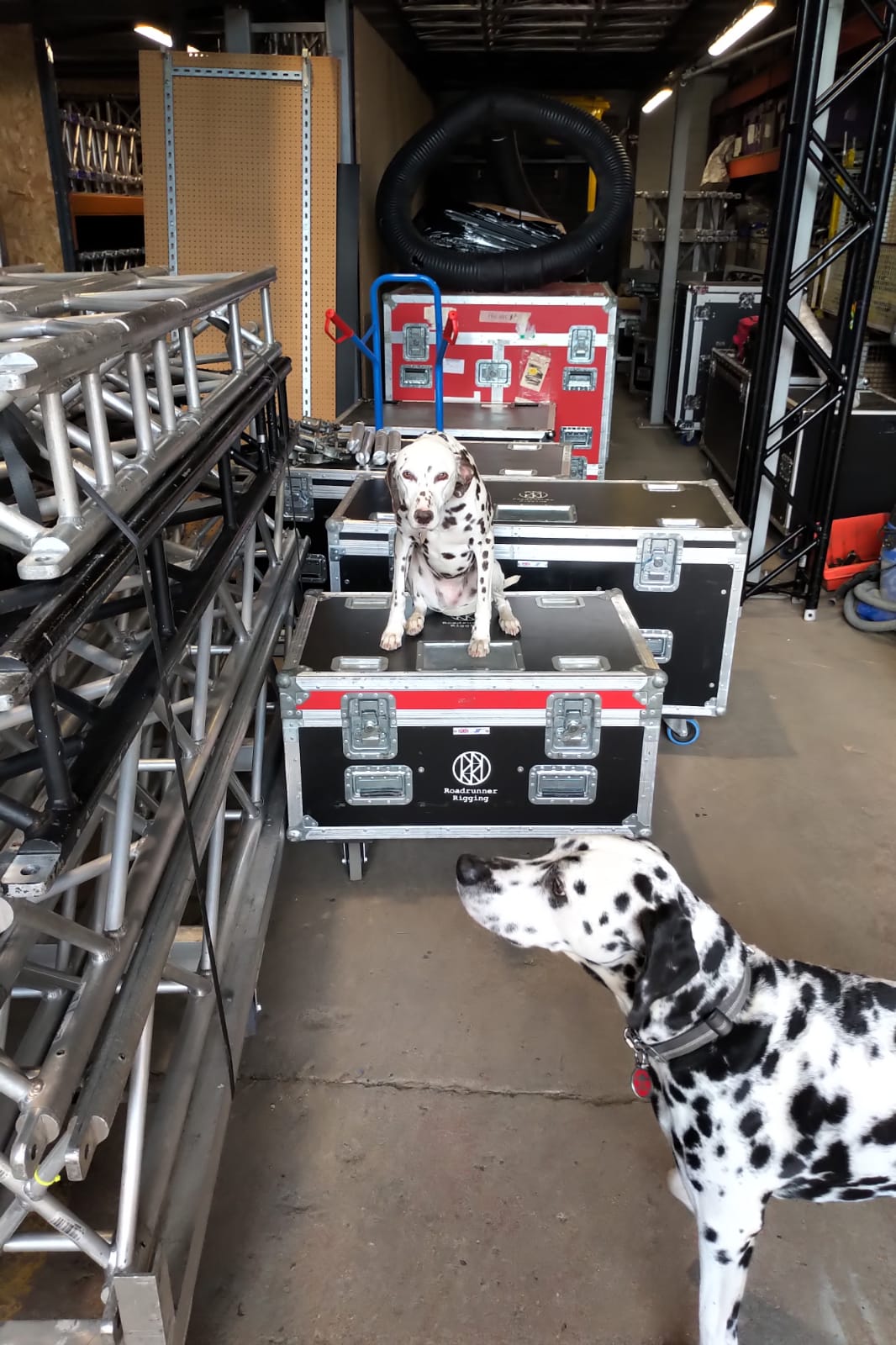
Battle of the Scientists
After having survived the preliminaries in December last year, 5 scientists were selected to participate in the final round of the "Battle of the Scientists" ("Wetenschapsbattle" in Dutch - https://www.wetenschapsbattle.be/?lang=en ). This event was held in the University Forum (UFO) in Ghent on 22 March, perfectly fitting in the Belgian Astronaut Week (21 to 25 March 2022) during which Belgium celebrates the 30th anniversary of the shuttle flight of Dirk Frimout - the first Belgian in space - and the 20th anniversary of Frank De Winne's journey in the International Space Station (ISS). The main purpose of this initiative is to make girls and boys interested in science and technology already at a young age (6-12 years).
The Battle of the Scientists is a unique and interactive competition in which 5 scientists present their research in a 10' talk to a room filled with about 400 primary school children, while thousands (at least 5000 registered) watched the event from their classroom through a livestream. The children organise the battle themselves and vote for the winning presentation. They do the preselection of the scientists, form a jury and present the show. They are time keepers and count the votes. This co-creation between children, scientists, teachers and communication coaches creates a completely new and versatile learning environment for all involved.
The theme for this year's battle was "space", and so the STCE sent in two applications, which were eventually both selected for the final round. Dr Elke D'Huys presented her work and thrilling experiences with solar storms, whereas Dr Petra Van Lommel glorified the fascinating and colorful polar lights. Petra certainly had to answer most of the questions from the kids, but the first prize of this year's Battle of the Scientists went to Marijn Timmer for his ongoing research on recycling urine from astronauts into breathable air during their future space mission to Mars. Underneath is a screenshot of the participants and presenters taken from the live stream. A gif is available in the online version of this news item at https://www.stce.be/news/579/welcome.html
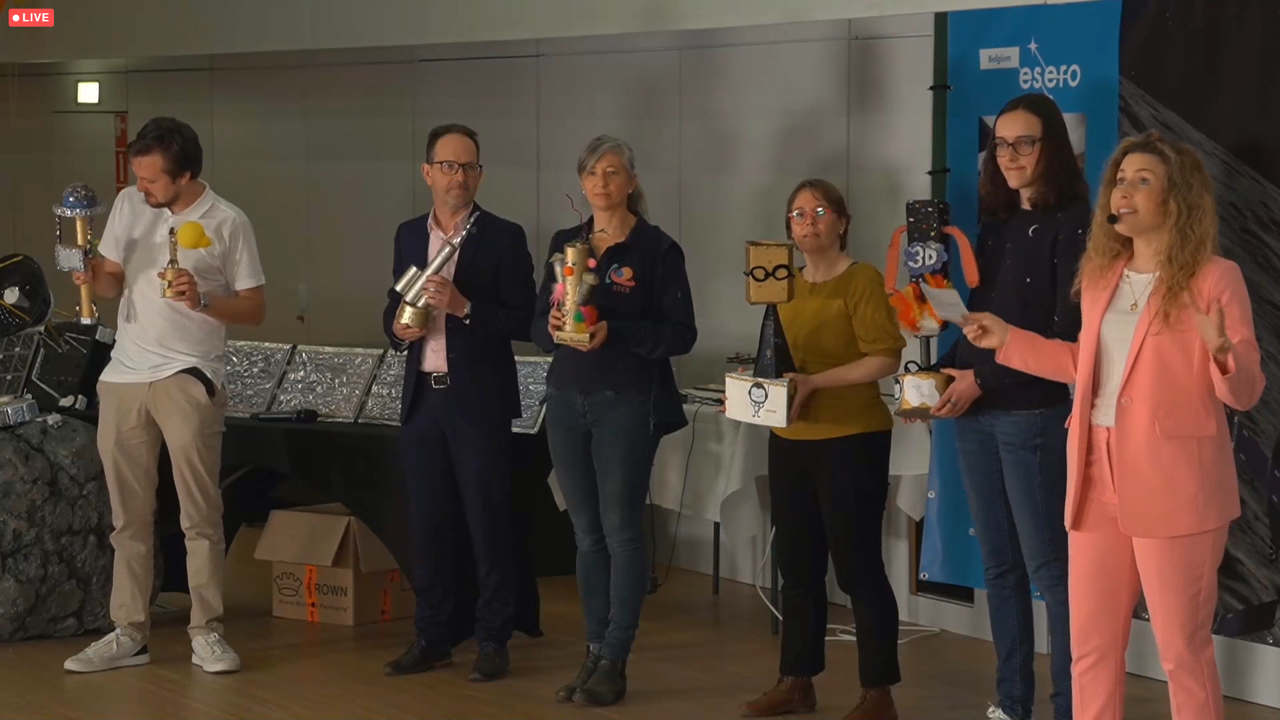
Review of solar activity
At the beginning of the week there were five active regions visible (NOAA ARs 2960, 2964, 2965, 2966, 2967). At the end of the week, NOAA ARs 2965 and 2972 were visible. The activity was dominated by NOAA AR 2965 (reached beta-gamma magnetic field configuration). It produced three M-class flares. The first one was an M2.0 flare, peaked at 08:40 UT on 14 March. The second one was an M1.4 flare, peaking at 12:39 UT on 15 March. The third one, an M1.5 flare, peaking at 22:46 UT, on 15 March.
A filament erupted from NOAA AR 2967, creating a CME first seen by SOHO/LASCO-C2 at 13:25 UT on March 16, with an angular width of about 100 degrees and projected speed of 360 km/s. The bulk of the CME was traveling to the east, but given the proximity of the source to the central meridian, an arrival to the Earth was predicted. This was the only CME with a possible Earth-influence of the week.
The greater than 10 MeV proton flux was at nominal levels throughout the week. The greater than 2MeV electron flux was below the 1000 pfu threshold. The electron fluence was at normal levels, the full week.
Review of geomagnetic activity
An ICME arrived to the Earth on 13 March (corresponding to a CME from 10 March). The magnetic field reached 25 nT, Bz went down to -23 nT, the solar wind speed peaked at 540 km/s. This caused moderate storm conditions with K_Bel and Kp reaching 6.
From 15 March onwards, the Earth was immersed in slow solar wind, until the arrival of the CME of 16 March, this happened on 20 March around 00:00 UT. It only produced unsettled geomagnetic conditions.
PROBA2 Observations (14 Mar 2022 - 20 Mar 2022)
Solar Activity
Solar flare activity fluctuated from very low to moderate during the week.
In order to view the activity of this week in more detail, we suggest to go to the following website from which all the daily (normal and difference) movies can be accessed: https://proba2.oma.be/ssa
This page also lists the recorded flaring events.
A weekly overview movie can be found here (SWAP week 625): https://proba2.sidc.be/swap/data/mpg/movies/weekly_movies/weekly_movie_2022_03_14.mp4
Details about some of this week's events can be found further below.
Monday Mar 14
If any of the linked movies are unavailable they can be found in the P2SC movie repository here: https://proba2.oma.be/swap/data/mpg/movies/
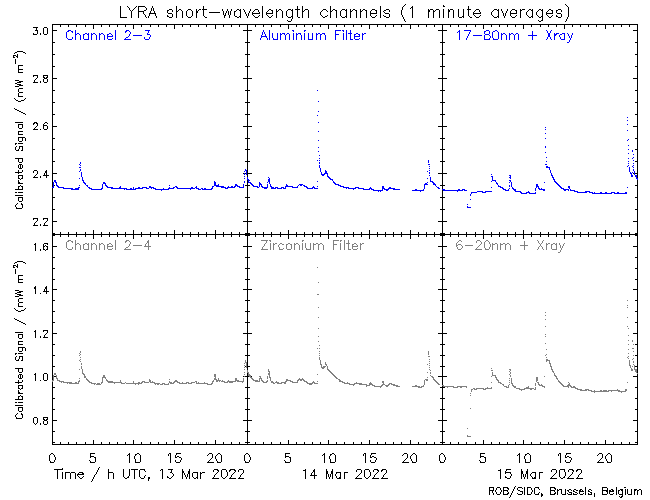
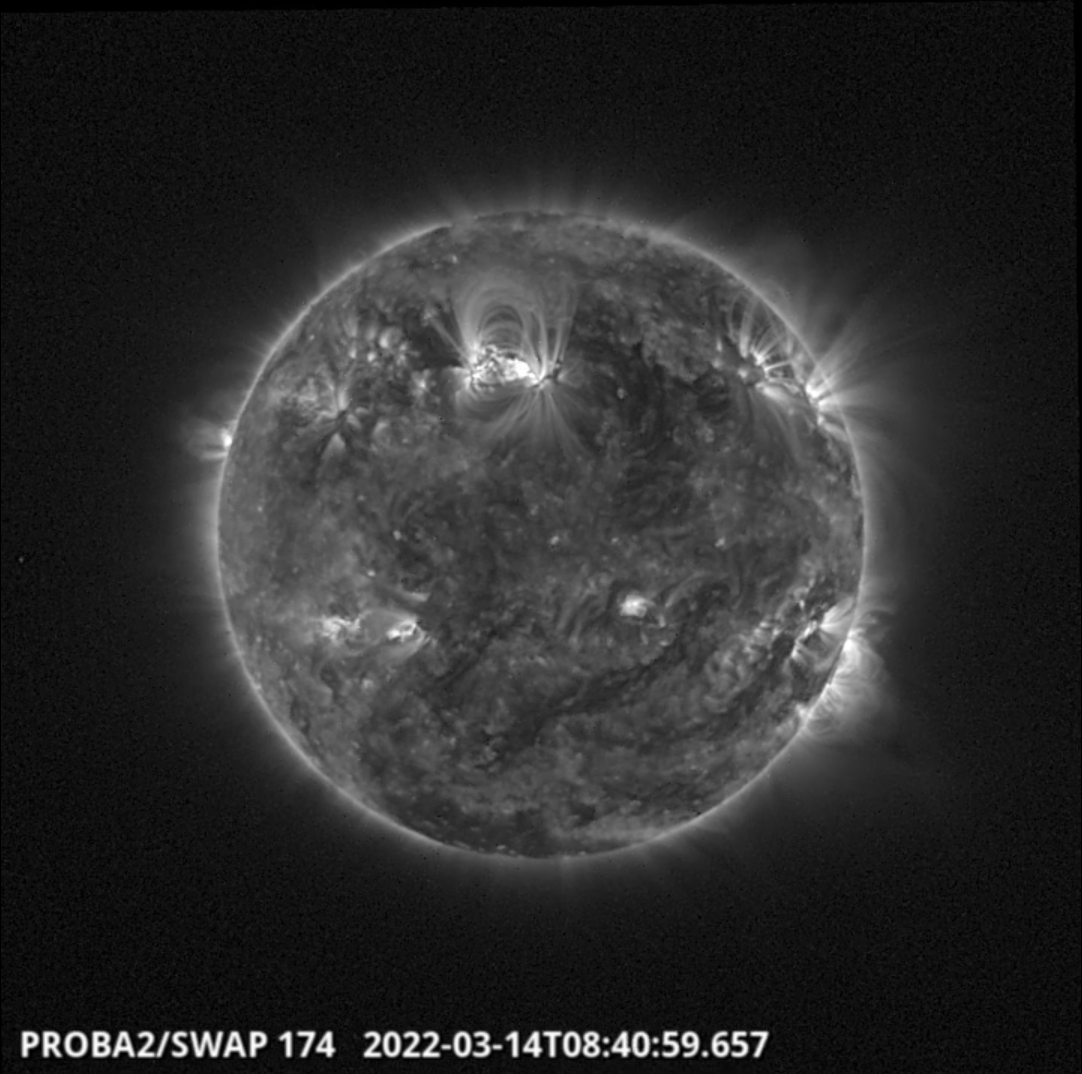
The largest flare of the week, an M2.0 flare, was observed by SWAP and LYRA. The flare is visible in near the central meridian on 2022-Mar-14, as shown in the SWAP image above taken at 08:40 UT.
Find a movie of the event here (SWAP movie): https://proba2.sidc.be/swap/movies/20220314_swap_movie.mp4
The International Sunspot Number by Silso
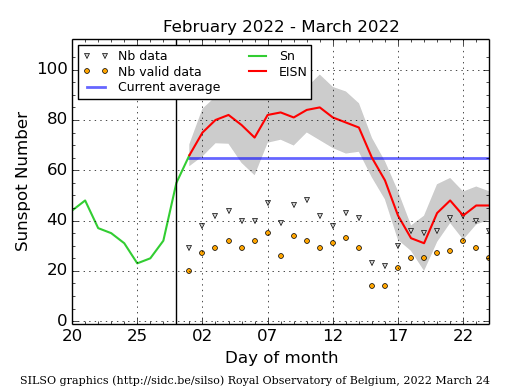
The daily Estimated International Sunspot Number (EISN, red curve with shaded error) derived by a simplified method from real-time data from the worldwide SILSO network. It extends the official Sunspot Number from the full processing of the preceding month (green line), a few days more than one solar rotation. The horizontal blue line shows the current monthly average. The yellow dots give the number of stations that provided valid data. Valid data are used to calculate the EISN. The triangle gives the number of stations providing data. When a triangle and a yellow dot coincide, it means that all the data is used to calculate the EISN of that day.
Noticeable Solar Events (14 Mar 2022 - 20 Mar 2022)
| DAY | BEGIN | MAX | END | LOC | XRAY | OP | 10CM | TYPE | Cat | NOAA |
| 14 | 0829 | 0840 | 0845 | M2.0 | 55 | 2965 | ||||
| 15 | 1233 | 1239 | 1244 | N24W10 | M1.4 | SN | 55 | 2965 | ||
| 15 | 2239 | 2246 | 2252 | N24W17 | M1.5 | SF | 55 | 2965 |
| LOC: approximate heliographic location | TYPE: radio burst type |
| XRAY: X-ray flare class | Cat: Catania sunspot group number |
| OP: optical flare class | NOAA: NOAA active region number |
| 10CM: peak 10 cm radio flux |
Geomagnetic Observations in Belgium (14 Mar 2022 - 20 Mar 2022)
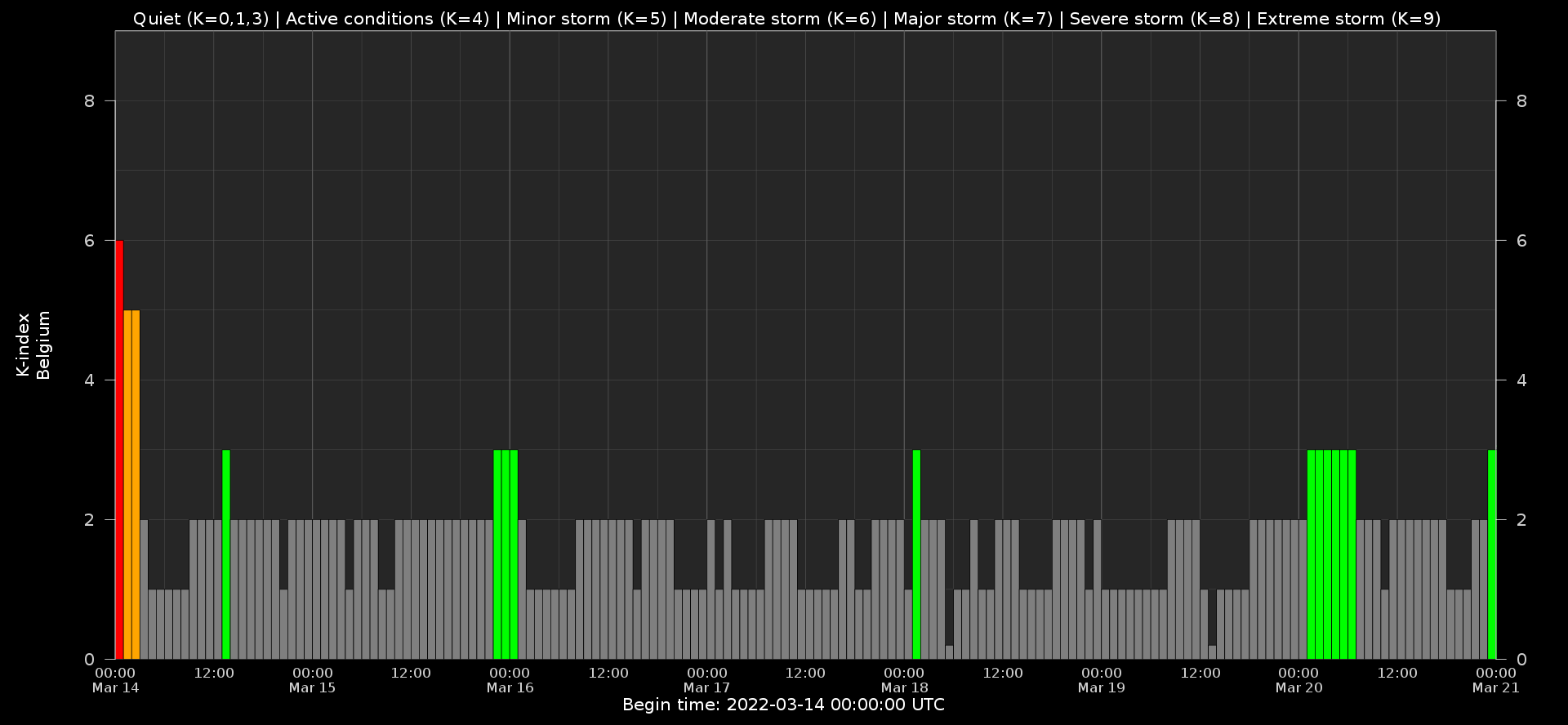
Local K-type magnetic activity index for Belgium based on data from Dourbes (DOU) and Manhay (MAB). Comparing the data from both measurement stations allows to reliably remove outliers from the magnetic data. At the same time the operational service availability is improved: whenever data from one observatory is not available, the single-station index obtained from the other can be used as a fallback system.
Both the two-station index and the single station indices are available here: http://ionosphere.meteo.be/geomagnetism/K_BEL/
The SIDC Space Weather Briefing
The Space Weather Briefing presented by the forecaster on duty from March 13 to 20. It reflects in images and graphs what is written in the Solar and Geomagnetic Activity report: https://www.stce.be/briefings/20220321_SWbriefing.pdf
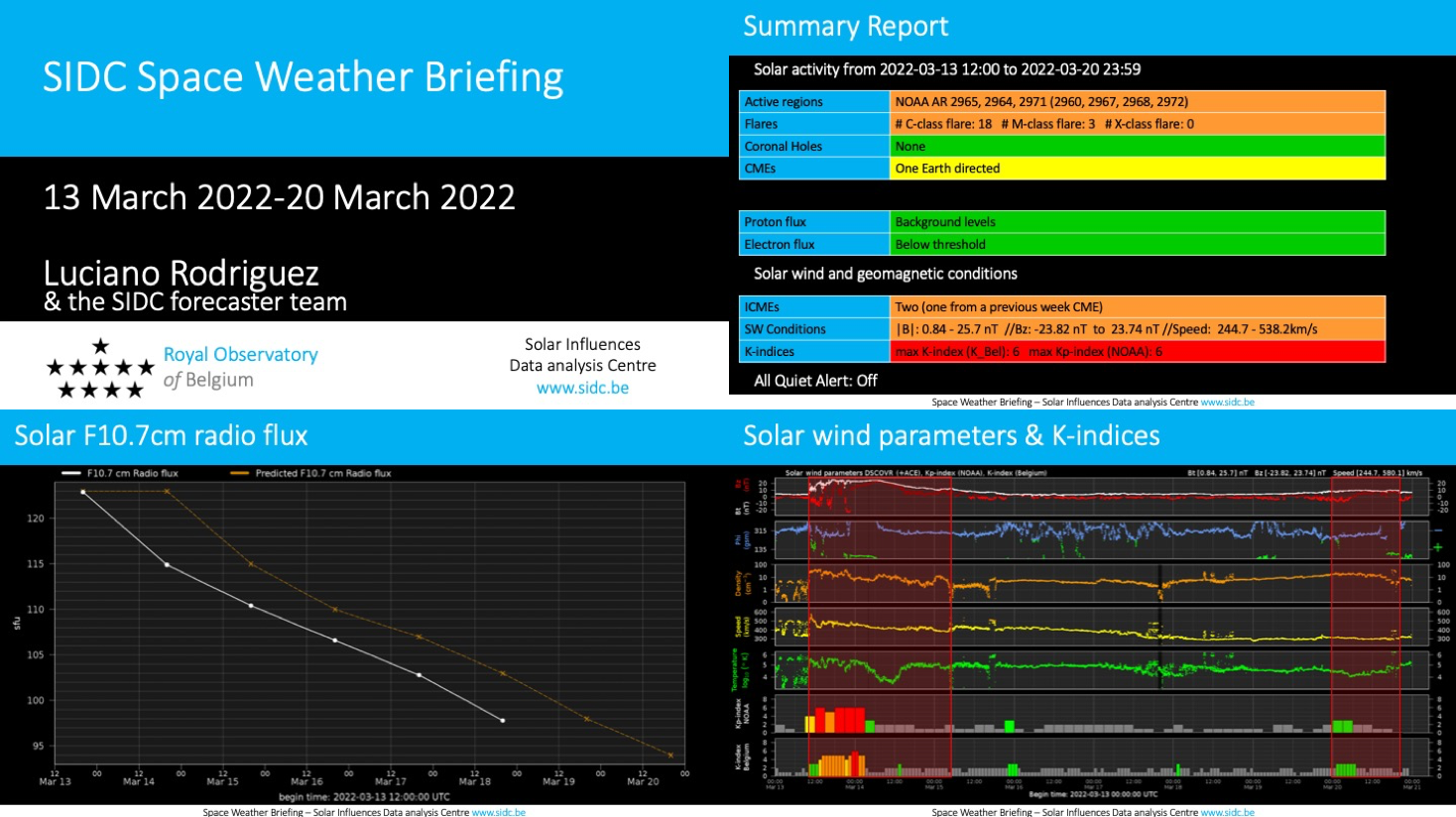
If you need to access the movies, contact us: stce_coordination at stce.be
Review of ionospheric activity (14 Mar 2022 - 20 Mar 2022)
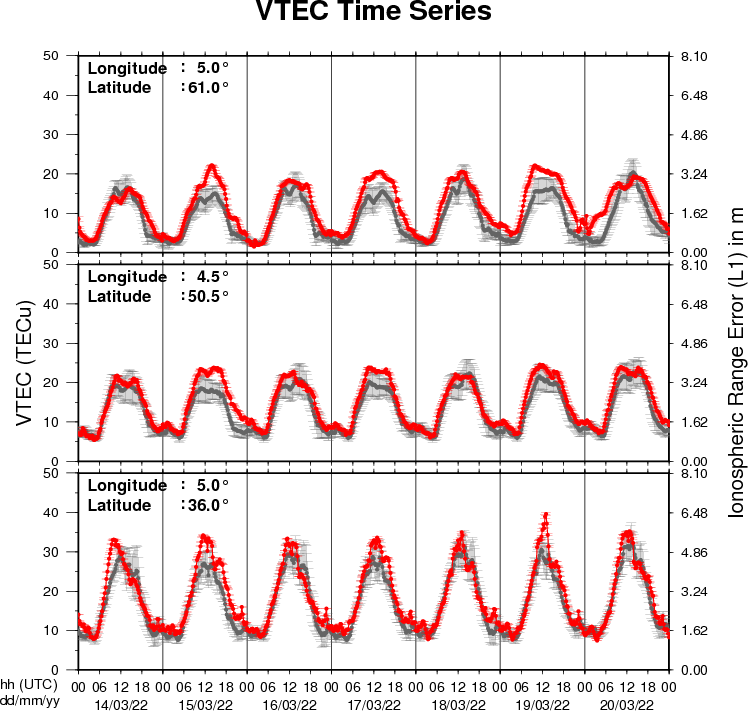
The figure shows the time evolution of the Vertical Total Electron Content (VTEC) (in red) during the last week at three locations:
a) in the northern part of Europe(N 61deg E 5deg)
b) above Brussels(N 50.5deg, E 4.5 deg)
c) in the southern part of Europe(N 36 deg, E 5deg)
This figure also shows (in grey) the normal ionospheric behaviour expected based on the median VTEC from the 15 previous days.
The VTEC is expressed in TECu (with TECu=10^16 electrons per square meter) and is directly related to the signal propagation delay due to the ionosphere (in figure: delay on GPS L1 frequency).
The Sun's radiation ionizes the Earth's upper atmosphere, the ionosphere, located from about 60km to 1000km above the Earth's surface.The ionization process in the ionosphere produces ions and free electrons. These electrons perturb the propagation of the GNSS (Global Navigation Satellite System) signals by inducing a so-called ionospheric delay.
See http://stce.be/newsletter/GNSS_final.pdf for some more explanations ; for detailed information, see http://gnss.be/ionosphere_tutorial.php
Action!
Check out our activity calendar: activities and encounters with the Sun-Space-Earth system and Space Weather as the main theme. We provide occasions to get submerged in our world through educational, informative and instructive activities.
If you want your event in our calendar, contact us: stce_coordination at stce.be
* March 25-26, Space Days in Leuven, Belgium
* April 5-17, SUN exhibit at the AfricaMuseum, Tervuren, belgium
* April 26, Public Lecture on the Solar Corona in EUV (Dutch), Urania, Hove, Belgium
* April 27-29, STCE at the Symposium on Space Educational Activities, Barcelona, Spain
* April 28, Public Lecture on SolO/EUI, Astropolis, Oostende, Belgium
* July 3, Public Lecture on ROB's mission to the Sun, Cosmodrome, Genk, Belgium
* August 25, Public Lecture on Space Weather and Aviation, Astropolis, Oostende, Belgium
* October 24-28, 18th European Space Weather Week, Zagreb, Croatia
Check: https://www.stce.be/calendar
